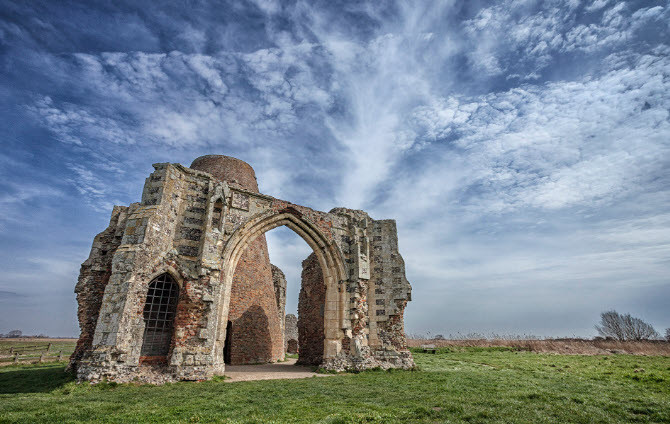Nestled on the serene banks of the River Bure in Norfolk, St Benet’s Abbey stands as a remarkable survivor of England’s turbulent religious history. As the only monastery to escape the Dissolution of the Monasteries under Henry VIII, it offers a unique glimpse into medieval monastic life.
A Sacred Site with Ancient Roots
St Benet’s Abbey holds the distinction of being Norfolk’s first Benedictine monastery, officially founded around 1020 by King Cnut. However, its spiritual significance stretches back even further.
- Early Hermits & Viking Raids
According to a 14th-century chronicle, a hermit named Suneman established a chapel here around 800 AD, dedicated to St Benedict. Other hermits joined him, forming a small religious community. However, Viking invasions in the late 9th century disrupted this early settlement. By the mid-10th century, another hermit, Wulfric, revived the site with seven companions, rebuilding the church and sustaining a religious community for decades. - Royal Patronage & Expansion
King Cnut, while staying in nearby Horning, granted the monks three manors (Horning, Neatishead, and Ludham) to support their work. This marked the abbey’s formal establishment. Construction of stone buildings began in the 11th century, with expansions in the 12th and 13th centuries. The abbey’s church was finally completed in 1274, surrounded by protective earthworks and a moat—remnants of which can still be seen today.
Medieval Struggles & Political Turmoil
Despite its royal connections, St Benet’s faced challenges:
- The Earl’s Rebellion & Lost Patronage
In 1075, Ralph de Gaul, Earl of East Anglia and a key patron, rebelled against William the Conqueror. His defeat led to his lands being granted to Roger Bigod, who favoured Thetford Priory instead, weakening St Benet’s influence. - Failed Saintly Ambitions
The abbey attempted to boost its prestige by promoting the cult of St Margaret of Holm, a local woman martyred in 1170 and buried beneath the high altar. Despite efforts, her veneration never gained widespread popularity. - Peasant Revolt & Court Roll Burning
In 1381, rebels stormed the abbey, mistakenly believing the Bishop of Norwich was present. When they couldn’t find him, they burned the abbey’s court rolls—destroying legal records of tenant obligations. The revolt was soon crushed, and the records painstakingly recreated.
The Abbey’s Miraculous Survival
When Henry VIII dissolved England’s monasteries (1536–1539), St Benet’s Abbey escaped suppression—the only one to do so. How?
- A Clever Loophole
In 1536, the Bishop of Norwich died, and Henry appointed Abbot William Rugge as his successor—with a catch. Rugge had to remain Abbot of St Benet’s, using the abbey’s funds to support his bishopric while maintaining a small monastic presence. Though the monastery was abandoned by 1545, it was never officially dissolved. To this day, the Bishop of Norwich holds the title of Abbot of St Benet’s and leads an annual service at the ruins.
What Remains Today
Though most buildings were dismantled for stone by 1579, key features endure:
- The Iconic Gatehouse & Windmill
The 14th-century gatehouse stands proudly by the river. In the 18th century, a drainage mill was built into its structure, though its sails were lost in 1863. Today, the ruins are a picturesque landmark for Broads boaters. - Abbey Church Ruins
Only fragments of the nave and transept walls remain, along with a wooden cross marking the high altar’s original site. - Monastic Fish Ponds & Earthworks
The abbey’s fish ponds—among England’s best-preserved—highlight its self-sufficient medieval economy. The surrounding earthwork defences are still visible.
Visiting St Benet’s Abbey
Location: Near Ludham, Norfolk Broads
Access:
- By Car: From Ludham, take Hall Road toward the River Bure. A narrow lane leads to a small parking area near the gatehouse.
- By Boat: Moor at the free riverside spot near the ruins.
- On Foot: Footpaths from Ludham village provide a scenic (but indirect) walk.
Admission: Free, with guided tours available May–September.
Why Visit?
St Benet’s Abbey is more than just ruins—it’s a testament to resilience, faith, and England’s layered history. Whether you arrive by land or water, its tranquil setting and fascinating past make it a must-see for history lovers.
Have you visited St Benet’s Abbey? Share your experience in the comments!
